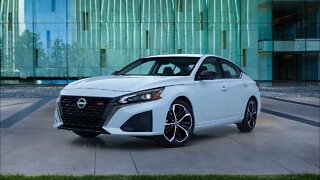Premium Only Content

2022 Toyota Prius Overview
Overview
The 2022 Toyota Prius remains a remarkably efficient hatchback, but it's no longer the must-have hybrid it once was. Its wedge-shaped design aims to maximize fuel economy, but it's not aesthetically pleasing. The powertrain musters a measly 121 horsepower, which amounts to lazy acceleration. And while the Prius Eco model boasts an EPA combined rating of 56 mpg, the Hyundai Ioniq Blue outperforms it, achieving 59 mpg. On the plus side, the Prius is the only compact hybrid that offers all-wheel drive, but that doesn't improve its apathetic driving manners. The Toyota just isn't nearly as compelling as the Honda Insight sedan, and the Toyota Corolla Hybrid is less expensive and almost as fuel efficient. Alas, the 2022 Prius struggles for relevancy in a segment it helped create.
What's New for 2022?
The Prius lineup adds a Nightshade model that's available in three different metallic colors: Silver, Super White, and Midnight Black. It brings black 17-inch wheels for front-drive models and 15-inchers with black lug nuts for all-wheel-drive examples. Inside, heating for the steering wheel and front seats comes standard.
Pricing and Which One to Buy
L Eco $25,650
LE $26,860
LE AWD-e $28,130
XLE $29,870
XLE AWD-e $30,570
Nightshade $30,570
Limited $33,945
While it's tempting to step up to the XLE model for its power-adjustable seats, heated seat cushions and steering wheel, expanded proximity-key function, and smartphone charging pad, to us, these features don't seem worth the nearly $4500 premium over the L Eco. The base model provides everything you need as well as some niceties such as passive entry on the driver's door and adaptive cruise control.
Engine, Transmission, and Performance
The Prius's hybrid powertrain doesn't deliver thrilling or even amusing acceleration, which is a shame. Several competitors prove that acceptable performance needn't be sacrificed in the pursuit of world-beating fuel economy. Nor does the 2022 Prius offer much in the way of driving enjoyment or refinement. All-wheel-drive models feature an electric motor that functions separately from the hybrid system and powers the rear wheels. Braking is a common gremlin for hybrid vehicles, which use a mix of regenerative and friction braking. Inconsistent or numb feedback from the brake pedal as we experienced in the Prius is often the trade-off and, combined with the low-rolling-resistance tires that most hybrids wear, can make for longer braking distances than what we see from similar-size nonhybrid vehicles.
Fuel Economy and Real-World MPG
According to the EPA, the thriftiest Prius Eco earns up to 58 mpg in the city and 53 mpg on the highway. Other front-drive models are rated for 54 mpg city and 50 mpg highway. All-wheel-drive examples fare a little worse, with ratings of 52 and 48 mpg, respectively. That doesn't always hold up in the real world, though. On our 75-mph fuel-economy testing loop, the front-drive Prius delivered a disappointing 46 mpg, undershooting its EPA rating by 4 mpg, while an XLE AWD-e returned 47 mpg. For more information about this car's fuel economy, visit the EPA's website.
Interior, Comfort, and Cargo
Even if the Prius were appointed in sumptuous leather, we'd still take issue with the center-mounted information gauges, which demand more of the driver's attention than a traditional setup does. Passengers have plenty of room to spread out in the Prius—there's space for four six-footers thanks to upright seating—but several rivals offer even more legroom for back-seat passengers. The hatchback body style of the Prius means there's a good amount of room for cargo behind the rear seat, and the dash-mounted shifter frees up space for storage cubbies in the front seat area. In the back, cubby storage is limited to two rather small door pockets and the cupholders found in the pull-down center armrest.
#WikiCar
#ToyotaPrius
#2022ToyotaPrius
-
 2:20
2:20
A collection of the best cars in the world
2 years ago2023 Nissan Altima Overview
214 -
 2:41:35
2:41:35
TimcastIRL
8 hours agoTrump US China Trade Deal Sees Market SKYROCKET, EO Signed To DROP Drug Costs | Timcast IRL
370K119 -
 3:11:22
3:11:22
Barry Cunningham
13 hours agoPRESIDENT TRUMP IS BRINGING PROSPERITY AND WEALTH TO AMERICA AND LIBERALS HAVE NOTHING TO SAY!
97.6K59 -
 1:50:15
1:50:15
Jamie Kennedy
1 day agoGhostwriting, Getting Fired, and Going Too Far | Ep 205 with Bill Dawes
40.8K2 -
 2:52:54
2:52:54
I_Came_With_Fire_Podcast
12 hours agoMEAD & MENTAL HEALTH W/ VIKINGS, OUTLAWS AND COWBOYS!
41.1K2 -
 9:00:06
9:00:06
RalliedLIVE
14 hours ago $4.15 earnedShotty Boys vs Ranked
86.9K3 -
 8:00:03
8:00:03
SpartakusLIVE
10 hours agoDuos w/ GloryJean || Monday MOTIVATION
28.2K1 -
 2:20:02
2:20:02
Tucker Carlson
9 hours agoDave Smith: Debating Douglas Murray, the “Woke Right” Narrative, and the Moment He Found God
158K157 -
 LIVE
LIVE
Eternal_Spartan
6 hours agoLive! Oblivion Viewers Choice Night | Come Hang w/ a USMC Vet and the Best Chat on Rumble! RTMP Test
183 watching -
 2:00:31
2:00:31
PandaSub2000
5 days agoThe Midnight Walk | PSVR2000
22.9K2